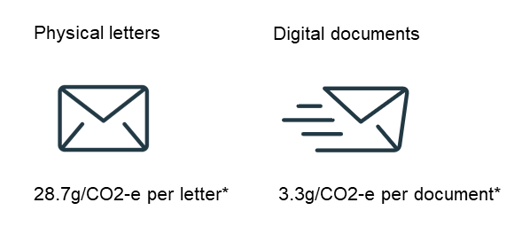The digital evolution of the postal industry: Navigating transformation

Governments and businesses are becoming increasingly conscious about the need for taking action to transition towards a low-carbon, climate-resilient economy, and citizens are pushing behind this development. A recent study by Triangle Management Services (commissioned by e-Boks) reveals, that 96% of professionals within the postal industry agree on the future trajectory of postal operators to be increasingly shaped by environmental sustainability concerns. Furthermore, 85% acknowledge that physical letter distribution markedly impacts the organisation’s CO2 emissions and resource usage.


passing through our platform each year, we are helping to significantly reduce CO2e emissions by enabling the transition to paperless distribution, minimizing both the use of paper and the physical transport of letters.
For more information, read the e-Boks COP 2024 report here.
At e-Boks we fully recognize the urgency and the need for capturing the benefits of digitalization for the environment, while also recognizing that Information and Communications Technology (ICT) can have a negative environmental and climate-related footprint, which needs to be simultaneously addressed.
Since our beginning in 2001, e-Boks has established its business by delivering sustainable digital communication through the Digital Postbox Platform, and has played an important role in the digital transition of the Danish society and economy over the past two decades.
With more than 540 million documents passing through our platform each year, we are helping to significantly reduce CO2e emissions by enabling the transition to paperless distribution, minimizing both the use of paper and the physical transport of letters.
As decision-makers across the world step up their efforts to reduce their material and carbon footprints, we looked at our contribution to the environmental footprint in Denmark over the past decade, and what a move to paperless post and document handling could mean in terms of paper saved and tonnes of CO2 saved.
We hope that these experiences can provide a blueprint for the environmental savings potential that a government or business may pursue in its own context and time horizon.
We have prepared a case study that shows the historical development of e-Boks in the Danish context, the digital transformation that we have been a part of, and its environmental impact.
The model below shows the historical development in e-Boks users from 2013 to 2021 combined with the historical development of digital documents available through the e-Boks platform compared to the total number of physical letters sent in Denmark.
From 2013 to 2021, the e-Boks user base increased from 4 million to 6 million in Denmark. During the same period, the volume of digital letters grew to three times the number of physical letters – 542 million documents were available through our platform in 2021.
The model shows how e-Boks has contributed to a significant shift in the way people communicate and send letters in Denmark over the past decade, and how it has been possible over time to create a tipping point from physical letters to digital post (achieved in 2016).

In recent years, we've witnessed a remarkable shift in the way we communicate, with the adoption of digital documents skyrocketing. This trend has not only transformed the way we exchange information but has also had a significant positive effect on our environment as demonstrated by the decreasing levels of CO2e emissions from both physical letters and digital documents. In 2021, CO2e emissions reached an all-time low, marking a pivotal moment in our fight against climate change.
As illustrated in the accompanying graph, CO2e emissions from both physical letters and digital documents have been on a steady decline. This encouraging trend is a testament to the power of technology and innovation in reducing our carbon footprint. In 2021, emissions from both sources reached their lowest levels in recent memory.
However, the most intriguing aspect of this shift is the stark difference in emission levels between physical letters and digital documents. Despite the fact that the number of digital documents sent has increased substantially, the overall CO2e emissions remain significantly lower than those associated with traditional physical letters. This insight is pivotal in understanding how transitioning to digital documents can make a substantial contribution to reducing our carbon footprint.

Model 2 tracks the development in physical letters and digital documents and shows the total emitted CO2e from each of these over a historic period from 2013 to 2021. While the number of physical letters has fallen to 181 million, the number of digital documents has increased, reaching 542 million in 2021, while still emitting less CO2e overall.
To quantify the environmental impact of this shift, our study delved into the specifics of CO2e emissions associated with both physical letters and digital documents. The results paint a compelling picture:
Physical Letters: Each physical letter, from production to distribution, emits approximately 28.7g of CO2e. This includes emissions from paper production (2.7g) and the energy-intensive process of distributing letters (26g).
Digital Documents: In contrast, digital documents, assuming an average size of 1 MB and usage on a computer with Wi-Fi, emit just 3.3g of CO2e per document. This remarkable reduction can be attributed to the virtual nature of digital documents, which eliminates the need for paper and reduces energy consumption.
Source: e-Boks UN Global Compact Communication on Progress 2024

The implications of these findings are profound. Shifting from physical letters to digital documents can lead to a reduction in CO2e emissions by approximately nine times according to the case study from Denmark. This remarkable reduction is a testament to the efficiency and sustainability of digital communication platforms, and it underscores the potential for substantial environmental benefits.
The transition to digital documents offers a myriad of advantages beyond reducing CO2e emissions. It enhances efficiency, reduces resource consumption, and streamlines communication processes.
In conclusion, the shift to digital documents represents a substantial step forward in our collective efforts to combat climate change. The data speaks for itself, highlighting the potential for significant reductions in CO2e emissions. By choosing digital over physical, we can not only enhance our operational efficiency but also contribute to a greener and more sustainable future for generations to come.
For more info on how e-Boks helps enterprises and public authorities decrease their environmental footprint, please view our latest "UN Global Compact Progress Report" here.